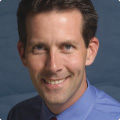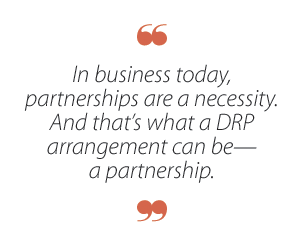
| Electronic Communication Yielding Multiple Benefits | |
| Lines of Convergence. Direct Repair Program participants seem to be finding common ground. | |
| Marketing Tactics | |
| Grange Affirms the Need for Speed | |
 |
| |||
| Lines of Convergence. Direct Repair Program participants seem to be finding common ground. | ||||
 By Eric Messerschmidt By Eric Messerschmidt | ||||
| It's easy to find dialogue and subsequent assenting or dissenting opinion on direct repair programs (DRPs); it's on the pages of industry trade publications, subject lines of weekly e-mail newsletters and serves as a topic for countless association meetings. Perhaps the reason the conversation is growing is because DRPs are touching more repair facilities than ever before. Four years ago, it was estimated that one-third of all U.S. repair facilities were involved in at least one DRP relationship.i According to the editor of Automotive Body Repair News (ABRN), the number of repair facilities involved in a DRP today stands at nearly 75 percent. International Autobody Congress and Exposition (NACE) Chairman Vernon Crump said the aforementioned statistics shouldn't be a surprise, since numerous seminars at the 2004 NACE event in Las Vegas addressed the importance of DRPs and maintaining a strong repair facility-insurer relationship. “If you see who registered to attend the show and what themes the seminars were covering,” said Crump, “there's no doubt DRPs are here to stay, and that shops have become active participants in the process.” So what is the reason for DRP growth in the industry? Who—or what—is driving future developments? In trying to get a handle on the topic, CCC UpFront talked with representatives from the insurance and repair industries, as well as gathered valuable insight from industry associations, global marketing firms and nationally recognized publications. What follows is dialogue aimed at the decisions, economics and influences existing within the DRP marketplace and what the future may look like. How Did We Get Here? In the early 90s, as technology evolved, the electronic DRP began to emerge. The burgeoning use of the Internet fueled rapid improvement in communication—and the industry adopted it with open arms. Today, 95 percent of repair facilities nationwide are online (with nearly half of those being broadband connections).iii This avenue of communication gave estimators and adjusters the opportunity to write, read and edit estimates electronically, avoiding manual re-writes and unnecessary cost. Repair facilities began to see the twofold benefit of a steady, heavier stream of business and quicker payment. Insurance companies were able to service their customers in a much quicker fashion— translating into increased customer satisfaction. Nationwide Insurance's associate vice president of material damage technical claims, Terry Fortner, believes perspective can get lost when looking at the evolution of the claims process. When he began with Nationwide in 1977, Fortner said it was common in the industry for it to take about 11days after an accident before an estimate was even written. “Today, the industry is moving toward a cycle time of 10 days (from start to finish),” remarked Fortner, adding that cutting cycle time is “the biggest win-win in the industry. No one loses.” John Arnold, owner of Arnold's Body Shop in Davenport, Iowa, said there were many aspects he had to consider when making his DRP decision—key among them being the commitment to communicate electronically. “Initially, it seemed (to repair facilities) DRP relationships were invented to reduce the claims processing costs for insurance carriers by transferring some of the claims functions to the body shop,” said Arnold. “It increased the fixed overhead costs of body shops that began to participate in such programs. From expenditures for different software systems to additional non-direct staff, the shops' costs initially went up.” DRPs as a Business Decision Michael Willins, editor-in-chief at ABRN, said repair facilities must be aware of the positive aspects in having a DRP relationship. “Obviously (repair facilities) believe such arrangements make business sense, otherwise they wouldn't have made the decision to enter into such agreements,” said Willins. “As shops gain familiarity with these programs and realize some success from them, those adversarial barriers logically will decline. In business today, partnerships are a necessity. And that's what a DRP arrangement can be—a partnership.”
Another key factor was logistics. KAH needed to find a way to efficiently manage a DRP network in light of its claims volume (approximately 100,000 claims per year) and broad territory. Implementing technology, such as electronic file sharing that included crucial information such as digital images, allowed them to cover territory that would have been otherwise impossible. “I think, realistically, it was the technology that allowed us the ability to manage the program,” added Williams. “We didn't have the presence—without the technology—to go out and effectively manage a DRP on our own.” Who, or What, is Driving Business? Jeremy Bowler, director of research projects at J.D. Power and Associates, said today's overall economic view charts a rough course for smaller facilities looking to survive without a DRP. “When all things are said and done, it's becoming more and more difficult for an individual shop (without a DRP) to compete,” said Bowler. “It seems that you have to consolidate your mix of business to be able to justify expenses, such as aluminum welding technology, training or whatever it might be…. These are a few in a number of different forces I think that are reducing the one-man shop or the single shop.” Insurance companies share the same set of concerns when it comes to driving business. Simply put, it is important for an insurance company to understand its place in a given geographic market and have sustainable DRP business model to support that market. Discussing KAH's recent exploration and entry into the marketplace, Williams said Kemper is cognizant of the number of DRPs it has in a given area so an economic balance exists. In a handful of cases, a turnabout existed where KAH pursued a particular repair facility. If the scenario sets up where an KAH's customers make a conscious decision to use a facility that isn't in their DRP network, Williams said KAH makes note of that. “If one of the reasons our customer doesn't select (the DRP repair facility), we ask them why they're not selecting it,” said Williams. “We track that and try to build that information into our system. So, if 10 people in Chicago in a given month want to go to one certain facility and that facility's business is not in our program, maybe it's a place that we need to take a look at.” Balancing Act “For the collision repair business (as a whole), the last few fiscal quarters have been ones of low net profit, or none at all,” said Arnold. “There are many market factors affecting this poor performance that are out of the realm of control of the entrepreneur. Survival has become a simultaneous, strong balance between increasing net profit and customer retention. Balancing or fitting together these two goals are a daily phenomenon. Businesses concentrating too heavily on one or the other will not survive. DRP relationships fall into this paradigm of balancing dollars and customer service.” Actively engaged in the customer process, Arnold has gotten to the point where he updates and posts his customer service index (CSI) ratings for the last two months, as well as the year, on his Web site. Those numbers are important to him as a business owner, as he can share them with his walk-in customers just as readily as he shares them with the “several insurance companies” of which he maintains a DRP relationship. They, too, are looking for strong CSI numbers to ensure their customers' happiness. Nationwide, according to Fortner, also pays very close attention to CSI numbers. “Our program is much more than simply a collection of body shops, in that we have certain performance criteria that we require of the shops in the Blue Ribbon Repair Service,” said Fortner. “We monitor CSI and inspect the quality of work. We look at the performance from an appraisal standpoint.” J.D. Powers' numbers lend credence to this customer satisfaction message. On Dec. 20, 2004, J.D. Power released its 2004 Collision Repair Satisfaction Study. Further emphasizing the desire to capitalize on satisfaction ratings, Erie Insurance rightly touted the fact that they'd received the highest marks in a nationally distributed press release the next day. The Importance of Satisfaction ABRN's Willins adds: “Today's vehicle owners want their vehicles fixed, quickly and correctly. They also need to feel comfortable with their choice of repair facilities. As a result, it is imperative for shop owners to gain the trust of vehicle owners—through improvements in services, via marketing efforts, maybe by adopting new types of services (such as mechanical repairs) that allow shops to form stronger, more lasting relationships with their customers. “Insurers make note of those shops that meet and exceed the vehicle owners' expectations, and those are the shops that are going to grow their DRP business. So, the customer will continue to play a pivotal role in this process.” The Future Another influencer, albeit infrequently discussed, are OE manufacturers. Crump believes a bellwether for the U.S. market remains the activities taking place in the European collision repair market. As a member of International Bodyshop Industry Symposium (IBIS) board, Crump said the changing fuel economy standards in Europe has resulted in advanced vehicle construction techniques designed to lower total vehicle weight. “If you look at the vehicles being constructed to meet fuel standards in Europe, a majority of them are based on aluminum structure platforms,” said Crump. “The result is for shops having to make substantial investments in advanced machinery and repairer education. The CAFE (Corporate Average Fuel Economy) standards, which will soon be raised here in the U.S., will have the same effect. The shops able to survive this change will tend to be the larger, multi-DRP variety.” Fortner agrees. “You have certain controls mandated by some of the OEMs now About ABRN About J.D. Power and Associates About Arnold's Body Shop About Nationwide About Kemper Auto and Home Eric Messerschmidt is vice president of growth strategy and alliances at CCC Information Services Inc.
| ||||
 Just like repair facilities, insurance companies complete a thorough analysis before beginning a DRP. Florida-based Kemper Auto and Home (KAH) recently completed that analysis, rolling out its national Clear Choice Claims Service program a little more than a year ago. According to Chuck Williams, material damage claims specialist for KAH, there were a couple of unique drivers that he noticed during the decision-making process. “We found in many instances that it was our customers asking us if we had a preferred shop list, since a lot of the carriers they had in the past were presenting them with that scenario,” said Williams.
Just like repair facilities, insurance companies complete a thorough analysis before beginning a DRP. Florida-based Kemper Auto and Home (KAH) recently completed that analysis, rolling out its national Clear Choice Claims Service program a little more than a year ago. According to Chuck Williams, material damage claims specialist for KAH, there were a couple of unique drivers that he noticed during the decision-making process. “We found in many instances that it was our customers asking us if we had a preferred shop list, since a lot of the carriers they had in the past were presenting them with that scenario,” said Williams.